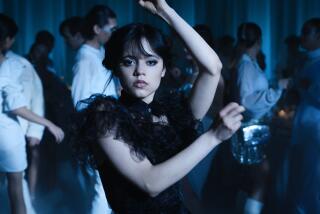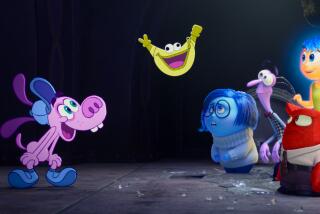Mickey Mouse, the Next Generation
- Share via
The animated Evil Queen from Disney’s “Snow White” stops to gaze in her Magic Mirror, which snaps with George Sanders-esque venom: “Forget it, Queenie, everyone’s fairer than you!” Meanwhile, “The Lion King’s” bug-eating meerkat Timon spits out his dinner, which turns out to be Jiminy Cricket, and a zoot-suited Big Bad Wolf blows a high note on the trumpet that shatters Cinderella’s glass slippers.
No, this isn’t a Disney parody from “Animaniacs.” It is Walt Disney Television Animation having fun at the company’s expense for “Disney’s House of Mouse,” a new Saturday morning series that for the first time brings practically the entire Disney canon of characters together in one place.
“House of Mouse,” which debuted Jan. 13 on ABC, is the next generation of the Emmy- and Annie-winning “Disney’s Mickey’s MouseWorks,” a series that spotlighted the studio’s “Fab Five” (Mickey, Minnie, Donald, Goofy and Daisy--actually six, if you include Pluto) in new short cartoons, which are being repackaged within the “House of Mouse” framework. The premise finds Mickey as co-owner (with Donald Duck) and emcee of a toon nightclub, struggling to keep the show going while contending with the backstage chaos abetted by maitre d’ Donald, head waiter Goofy (who supervises a platoon of penguins from “Mary Poppins”), production manager Minnie Mouse and star-struck hostess Daisy Duck. The rest of Disney’s catalog of characters--up to 100 per episode--are seen as nightclub patrons and guest stars.
According to Barry Blumberg, executive vice president of Disney’s television animation, “House of Mouse” is the result of wanting to package the “MouseWorks” cartoons within a stronger connecting format.
“This was Mickey Mouse, and we wanted everything just so,” he says. Working with the TV animation division’s dream team, executive producers Roberts Gannaway and Tony Craig, who had already turned out “The Lion King’s Timon and Pumbaa,” the animated TV series based on the film, and “101 Dalmatians,” as well as “MouseWorks,” a format was created that in Blumberg’s view “became more than just glue, it created an exciting environment to support these cartoons and give insight into who all these characters really are.”
If the goal of “MouseWorks” was to return Mickey and company to their comedy cartoon roots, and present them as actual characters to a generation of viewers who know them chiefly as marketing and licensing icons or homogenized theme-park figures, “House of Mouse” aims to make them relevant to today’s audience.
Does that mean the Mickster is suddenly becoming hip?
“I’ve been trying to avoid the words ‘hip’ and ‘edgy,’ because sometimes those can have negative connotations, and signify something trendy and not lasting,” Gannaway says. “We want to make him appeal to a modern audience, but without forsaking any of the character.”
Adds Craig: “If [Mickey] intermingles with Pocahontas and Hercules and ‘Lion King’ characters, characters that are owned by the children of today, it instantly brings Mickey up to also being owned by the children of today.”
Surprisingly, the studio, which in the recent past had been as diligently protective of its iconic characters as it was hesitant to intermingle the different character sets, came to embrace the notion. “Everybody thought it was really funny to loosen up a bit and let the characters be who they were and have some fun, instead of being so stiff,” Craig says.
“At the very early stages the meetings and presentations were interesting,” Blumberg admits. “But as we pursued the idea, the people who might have had a problem with it were satisfied that everybody was being treated with respect and that everybody was being true to their characters. Hades and Ariel may occupy the same space, but they’re going to be themselves.”
There are still parameters, however. The characters from the feature “Tarzan,” for instance, will not be clubbing at the House of Mouse for legal reasons. And Gannaway and Craig have deliberately avoided using characters that are inherently dramatic, such as Quasimodo and Frollo from the animated film “The Hunchback of Notre Dame.”
The biggest concern about using the feature characters, though, was not how they would be portrayed, but how they would look. Like all animated series for television, “Disney’s House of Mouse” is animated overseas. To ensure the graphic quality of those characters, the producers took measures beyond the normal TV tooning realm.
“We put a person in place to take our storyboards and do a model drawing of the feature characters in that storyboard pose so there will be no question in the minds of the animators as to what it was supposed to look like,” says Craig. If available, the original model sheets from a feature film are used to ensure authenticity.
The big-name voice talents behind the feature characters, including James Woods (Hades), Jason Alexander (“Hunchback’s” Hugo), Jerry Orbach (“Beauty and the Beast’s” Lumiere) and Robby Benson (the Beast) have all been happy to reprise their roles, according to Gannaway. “They really enjoy seeing the character live again and they enjoy that next level of having a little fun with it,” she says.
The studio’s regular Fab Five voices--Wayne Allwine as Mickey, Russi Taylor as Minnie, Tony Anselmo as Donald, Bill Farmer as Goofy and Tress MacNeille as Daisy--are all participating, and Brian Setzer was engaged to write and perform the “House of Mouse” theme.
Obviously, no one is ever going to confuse Mickey and Donald with Ren and Stimpy, stars of the groundbreaking Nickelodeon series “The Ren & Stimpy Show” created by cartoon maverick John Kricfalusi that paved the way for the edgier, hipper kids animation of the 1990s. But Gannaway feels that “Disney’s House of Mouse” is making the venerable, and lately underutilized, characters appeal to the most cartoon-literate audience in history.
“Today’s audience has been exposed to everything from ‘South Park’ to ‘Powerpuff Girls’ to all the old Warner Bros. cartoons, and those cartoons can do things that we obviously cannot,” he says. “But no one else can do Cinderella jokes or Timon and Pumbaa jokes except us . . . and Mickey. So this is a way of doing something to make him accessible and fresh for today’s audience without copying or mimicking some of the great things that are being done out there.”
*
* “House of Mouse” airs Saturdays at 11:30 a.m. on ABC. The network has rated it TV-G (suitable for all ages).
More to Read
The complete guide to home viewing
Get Screen Gab for everything about the TV shows and streaming movies everyone’s talking about.
You may occasionally receive promotional content from the Los Angeles Times.






